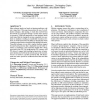20 search results - page 1 / 4 » Dynamic Taint Propagation for Java |
ACSAC
2005
IEEE
13 years 10 months ago
2005
IEEE
Improperly validated user input is the underlying root cause for a wide variety of attacks on web-based applications. Static approaches for detecting this problem help at the time...
HPCA
2008
IEEE
14 years 4 months ago
2008
IEEE
This paper presents FlexiTaint, a hardware accelerator for dynamic taint propagation. FlexiTaint is implemented as an in-order addition to the back-end of the processor pipeline, ...
EUROSYS
2006
ACM
14 years 1 months ago
2006
ACM
Many software attacks are based on injecting malicious code into a target host. This paper demonstrates the use of a wellknown technique, data tainting, to track data received fro...
KBSE
2007
IEEE
13 years 10 months ago
2007
IEEE
Programs written in languages that provide direct access to memory through pointers often contain memory-related faults, which may cause non-deterministic failures and even securi...
IEEEARES
2009
IEEE
13 years 11 months ago
2009
IEEE
Dynamic taint analysis (DTA) is a technique used for tracking information flow by propagating taint propagation across memory locations during program execution. Most implementat...

